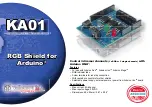
FCM 300 Series
MG.03.B6.2G - VLT is a registered Danfoss trademark
To ensure low, harmonic currents, FCM 300 has
intermediate circuit coils as standard..
THD (current)
≤
54%
The voltage distortion on the AC Line supply
depends on the size of the harmonic currents
multiplied by the supply impedance for the frequency
in question.
The total voltage distortion THD is calculated on the
basis of the individual voltage harmonics using the
following formula:
THD =
(%)
U
1
■
AC Line supply Interference/Harmonics
A FCM 300 draws a non-sinusoidal current from the
AC Line which increases the input current I
RMS
. A
non-sinusoidal current can be transformed by
means of a Fourier analysis and split up into sine
wave currents with different frequencies, i.e.
different harmonic currents I
N
with 60 Hz as the
basic frequency:
Harmonic currents I
1
I
5
I
7
I
11
Hz
60 Hz
300 Hz 420 Hz 660 Hz
In/I1 [%]
100%
44% 29% 8%
The harmonics do not affect the power
consumption directly, but increase the heat losses in
the installation (transformer, cables). Consequently,
in plants with a rather high percentage of non-linear
loads, it is important to maintain harmonic currents
at a low level to avoid overload of the transformer
and high temperature in the cables.
Some of the harmonic currents might disturb
communication equipment connected to the same
transformer or cause resonance in connection with
power-factor correction equipment.
Special conditions
√
U
2
2
+ . . .
+ U
N
2
Power factor =
=
■
Power Factor
The power factor is the relation between I
1
and I
RMS
.
The power factor for 3-phase control
=
The power factor indicates the extent to which the
FCM 300 imposes a load on the AC Line supply.
The lower the power factor, the higher the I
RMS
for
the same HP/kW performance.
In addition, a high power factor indicates that the
different harmonic currents are low.
3 x U x I
1
x cos
ϕ
1
3 x U x I
RMS
I
R M S
I
1
I
R M S
I
RMS
= I
1
2
+ I
5
2
+ I
7
2
+ . . . + I
n
2
I
1
x cos
ϕ
1
≈
0.9 since cos
ϕ
= 1
18-4













































